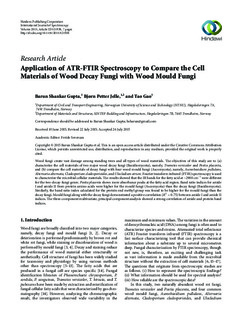| dc.contributor.author | Gupta, Barun Shankar | |
| dc.contributor.author | Jelle, Bjørn Petter | |
| dc.contributor.author | Gao, Tao | |
| dc.date.accessioned | 2017-12-29T20:23:38Z | |
| dc.date.available | 2017-12-29T20:23:38Z | |
| dc.date.created | 2015-07-26T11:49:50Z | |
| dc.date.issued | 2015 | |
| dc.identifier.citation | International Journal of Spectroscopy. 2015, 2015 . | nb_NO |
| dc.identifier.issn | 1687-9449 | |
| dc.identifier.uri | http://hdl.handle.net/11250/2473856 | |
| dc.description.abstract | Wood fungi create vast damage among standing trees and all types of wood materials. The objectives of this study are to (a) characterize the cell materials of two major wood decay fungi (Basidiomycota), namely, Trametes versicolor and Postia placenta, and (b) compare the cell materials of decay fungi with four wood mould fungi (Ascomycota), namely, Aureobasidium pullulans, Alternaria alternata, Cladosporium cladosporioides, and Ulocladium atrum. Fourier transform infrared (FTIR) spectroscopy is used to characterize the microbial cellular materials. The results showed that the IR bands for the fatty acid at ∼2900 cm−1 were different for the two-decay-fungi genre. Postia placenta shows more absorbance peaks at the fatty acid region. Band ratio indices for amide I and amide II from protein amino acids were higher for the mould fungi (Ascomycota) than the decay fungi (Basidiomycota). Similarly, the band ratio index calculated for the protein end methyl group was found to be higher for the mould fungi than the decay fungi. Mould fungi along with the decay fungi demonstrated a positive correlation (푅2=0.75) between amide I and amide II indices. The three-component multivariate, principal component analysis showed a strong correlation of amide and protein band indices | en |
| dc.description.sponsorship | Acknowledgments. The authors are thankful to the Research Council of Norway, Viken Skog BA, Treindustrien, the Wood Technology Research Fund at the Norwegian Institute of Wood Technology, Jotun AS, and Kebony ASA for the financial support and to the Norwegian University of Life Sciences (UMB), the Norwegian Forest and Landscape Institute, and the Norwegian Institute of Wood Technology for research cooperation. Additionally, the authors would like to acknowledge valuable comments from Dr. Per Jostein Hovde from NTNU and Dr. Lone Ross Gobakken from the Norwegian Forest and Landscape Institute at Ås, Norway. | en |
| dc.language.iso | eng | nb_NO |
| dc.publisher | Hindawi | nb_NO |
| dc.rights | Attribution-NonCommercial-NoDerivatives 4.0 Internasjonal | en |
| dc.rights.uri | http://creativecommons.org/licenses/by-nc-nd/4.0/deed.no | * |
| dc.title | Application of ATR-FTIR Spectroscopy to Compare the Cell Materials of Wood Decay Fungi with Wood Mould Fungi | en |
| dc.type | Journal article | nb_NO |
| dc.type | Peer reviewed | nb_NO |
| dc.description.version | publishedVersion | nb_NO |
| dc.rights.holder | © 2015 Barun Shankar Gupta et al. This is an open access article distributed under the Creative Commons Attribution License, which permits unrestricted use, distribution, and reproduction in any medium, provided the original work is properly cited. | en |
| dc.subject.nsi | VDP::Technology: 500 | nb_NO |
| dc.source.pagenumber | 7 | nb_NO |
| dc.source.volume | 2015 | nb_NO |
| dc.source.journal | International Journal of Spectroscopy | nb_NO |
| dc.identifier.doi | 10.1155/2015/521938 | |
| dc.identifier.cristin | 1255115 | |
| cristin.unitcode | 7401,30,40,0 | |
| cristin.unitname | Arkitektur, byggematerialer og konstruksjoner | |
| cristin.ispublished | true | |
| cristin.fulltext | original | |
| cristin.qualitycode | 1 | |

